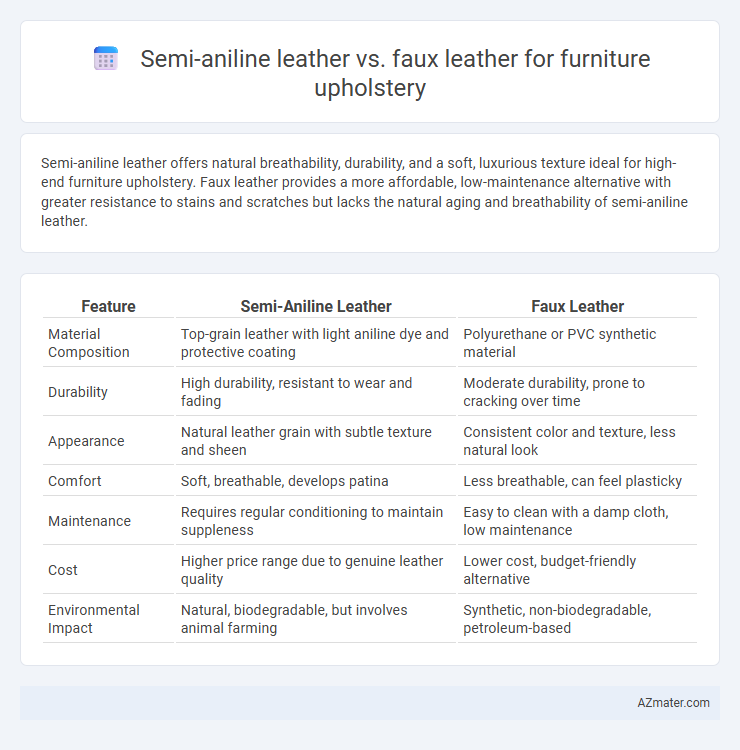Semi-aniline leather offers natural breathability, durability, and a soft, luxurious texture ideal for high-end furniture upholstery. Faux leather provides a more affordable, low-maintenance alternative with greater resistance to stains and scratches but lacks the natural aging and breathability of semi-aniline leather.
Table of Comparison
| Feature | Semi-Aniline Leather | Faux Leather |
|---|---|---|
| Material Composition | Top-grain leather with light aniline dye and protective coating | Polyurethane or PVC synthetic material |
| Durability | High durability, resistant to wear and fading | Moderate durability, prone to cracking over time |
| Appearance | Natural leather grain with subtle texture and sheen | Consistent color and texture, less natural look |
| Comfort | Soft, breathable, develops patina | Less breathable, can feel plasticky |
| Maintenance | Requires regular conditioning to maintain suppleness | Easy to clean with a damp cloth, low maintenance |
| Cost | Higher price range due to genuine leather quality | Lower cost, budget-friendly alternative |
| Environmental Impact | Natural, biodegradable, but involves animal farming | Synthetic, non-biodegradable, petroleum-based |
Introduction to Semi-Aniline and Faux Leather
Semi-aniline leather features a thin protective topcoat that enhances durability while preserving the natural texture and softness of the hide, making it a premium choice for furniture upholstery. Faux leather, typically crafted from polyurethane or PVC, offers a cost-effective and animal-friendly alternative with high resistance to stains and wear, though it lacks the breathability and aging characteristics of genuine leather. Both materials cater to different needs in furniture design, balancing aesthetics, maintenance, and budget considerations.
Understanding Semi-Aniline Leather: Key Features
Semi-aniline leather features a thin protective coating preserving its natural texture and breathability, offering a soft feel with moderate stain resistance. It retains visible natural markings and develops a unique patina over time, enhancing its aesthetic appeal for high-end furniture upholstery. This leather type balances durability with comfort, distinguishing it from faux leather's synthetic composition and uniform appearance.
What is Faux Leather? Composition and Benefits
Faux leather, also known as synthetic leather, is a man-made material composed primarily of polyurethane (PU) or polyvinyl chloride (PVC) layered over a fabric base, designed to mimic the appearance and texture of genuine leather. This material offers several benefits for furniture upholstery, including affordability, durability, resistance to stains and fading, and ease of maintenance compared to natural leather options like semi-aniline. Faux leather's consistency in color and texture makes it a popular choice for modern furniture designs, providing a sleek aesthetic without the environmental and ethical concerns associated with animal leather.
Visual Appeal: Comparing Aesthetics
Semi-aniline leather offers a natural, rich texture with subtle color variations and a soft, matte finish that enhances the depth and character of furniture upholstery. Faux leather presents a more uniform appearance with consistent color and texture, often lacking the nuanced grain and organic imperfections found in semi-aniline leather. The authentic look of semi-aniline leather adds warmth and sophistication, while faux leather provides a sleek, modern aesthetic that is easier to maintain.
Comfort and Softness: User Experience
Semi-aniline leather offers superior comfort and softness for furniture upholstery due to its natural grain and minimal surface coating, allowing the material to breathe and adapt to body temperature. Faux leather, while durable and easier to maintain, often lacks the supple feel and breathability of semi-aniline leather, leading to a less comfortable seating experience over extended periods. Users typically prefer semi-aniline leather for its luxurious softness and natural comfort that enhances prolonged use.
Durability and Longevity: Which Lasts Longer?
Semi-aniline leather, treated with a subtle protective coating, offers a balance of natural texture and enhanced durability, making it resistant to wear and aging with proper maintenance. Faux leather, crafted from synthetic materials like polyurethane, tends to resist stains and scratches better initially but may degrade faster under prolonged exposure to sunlight and temperature fluctuations. Semi-aniline leather generally lasts longer in high-use furniture due to its ability to develop a patina rather than crack or peel, whereas faux leather often requires earlier replacement due to surface cracking and fading.
Maintenance Requirements for Each Material
Semi-aniline leather requires regular cleaning with specialized leather conditioners to maintain its natural texture and prevent fading, while avoiding harsh chemicals that can damage its surface. Faux leather demands less intensive maintenance, mainly needing routine wiping with mild soap and water to prevent dirt buildup and cracking. Both materials benefit from avoiding prolonged exposure to direct sunlight and heat sources to preserve their appearance and durability over time.
Environmental Impact: Sustainability Considerations
Semi-aniline leather, derived from natural animal hides, offers durability and breathability but involves higher environmental costs due to livestock farming, water consumption, and chemical tanning processes. Faux leather, typically made from polyurethane or PVC, avoids animal agriculture impacts but poses challenges with synthetic production, including non-biodegradability and reliance on fossil fuels. Choosing sustainable furniture upholstery requires balancing semi-aniline leather's natural origins and biodegradability against faux leather's lower immediate ecological footprint and innovations in bio-based or recycled materials.
Cost Comparison: Value for Money
Semi-aniline leather upholstery offers a premium aesthetic and durability but comes at a significantly higher price point, making it a long-term investment for luxury furniture. Faux leather provides a budget-friendly alternative with lower upfront costs and easier maintenance, delivering good value for money in high-traffic or casual settings. Cost comparison reveals semi-aniline leather appeals to consumers prioritizing quality and longevity, whereas faux leather suits those seeking affordability and practicality.
Choosing the Right Upholstery for Your Furniture
Semi-aniline leather offers a natural, breathable surface with minimal pigment coating, making it softer and more durable for high-quality furniture upholstery. Faux leather, made from synthetic materials like polyurethane, provides a budget-friendly, stain-resistant alternative that is easier to clean but lacks the authentic texture and breathability of genuine leather. When choosing upholstery, consider factors such as durability, maintenance, budget, and the desired aesthetic to select semi-aniline leather for luxury and longevity or faux leather for affordability and ease of care.

Infographic: Semi-aniline leather vs Faux leather for Furniture upholstery
 azmater.com
azmater.com